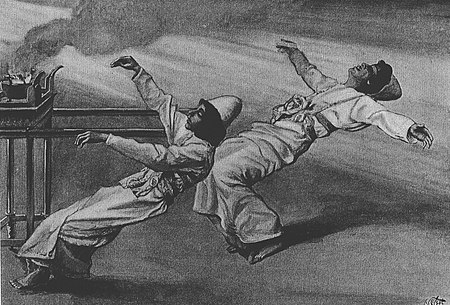
Back Schemini German Shemini Spanish Shemini French פרשת שמיני HE Shemini (parsyah) ID Shemini Italian Shemini (parsyah) JV Shemini (Parashá) Portuguese Шмини (недельная глава) Russian פרשת שמיני YI

Shemini, Sh'mini, or Shmini (שְּׁמִינִי—Hebrew for "eighth", the third word, and the first distinctive word, in the parashah) is the 26th weekly Torah portion (פָּרָשָׁה, parashah) in the annual Jewish cycle of Torah reading and the third in the Book of Leviticus. Parashah Shemini tells of the consecration of the Tabernacle, the deaths of Nadab and Abihu, and the dietary laws of kashrut (כַּשְׁרוּת). The parashah constitutes Leviticus 9:1–11:47. It is made up of 4,670 Hebrew letters, 1,238 Hebrew words, 91 verses, and 157 lines in a Torah Scroll (סֵפֶר תּוֹרָה, Sefer Torah).[1]
Jews read it the 25th or 26th Sabbath after Simchat Torah, in late March or April.[2] In years when the first day of Passover falls on a Sabbath (as it did in 2018 and 2019), Jews in Israel and Reform Jews read the parashah following Passover one week before Conservative and Orthodox Jews in the Diaspora, for Jews in Israel and Reform Jews celebrate Passover for seven days and thus read the next parashah (in 2018, Shemini) on the Sabbath one week after the first day of Passover, while Conservative and Orthodox Jews in the Diaspora celebrate Passover for eight days and read the next parashah (in 2018, Shemini) one week later. In some such years (for example, 2018), the two calendars realign when Conservative and Orthodox Jews in the Diaspora read Behar together with Bechukotai while Jews in Israel and Reform Jews read them separately.[3]
- ^ "Torah Stats for VaYikra". Akhlah Inc. Retrieved October 4, 2023.
- ^ "Parashat Shmini". Hebcal. Retrieved March 25, 2015.
- ^ See Hebcal Jewish Calendar and compare results for Israel and the Diaspora.
© MMXXIII Rich X Search. We shall prevail. All rights reserved. Rich X Search